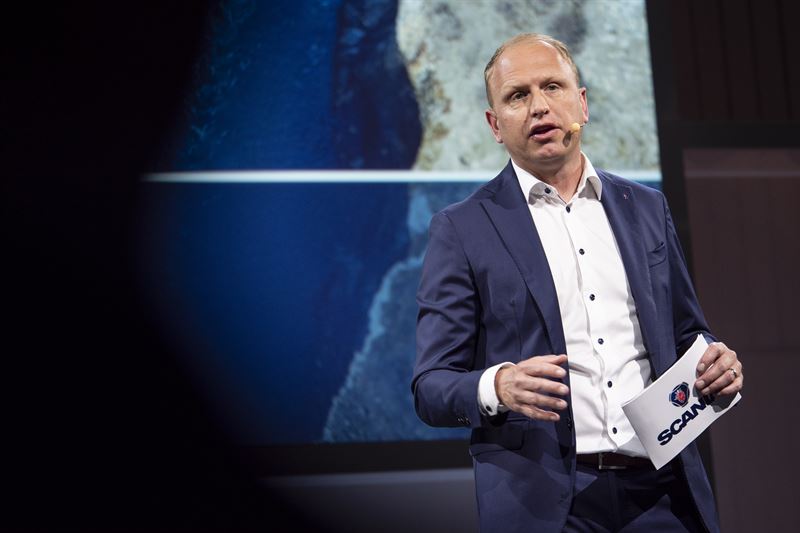Commercial transport can be fossil-free by 2050

A fossil-free commercial transport system in the timeframe of the Paris Agreement target is not only possible, but also financially attractive from a societal perspective. This is the key conclusion of a study initiated by Scania.
“Reaching zero CO2 emissions in our sector in the timeframe of the Paris Agreement is attainable but will call for change at an unprecedented high speed, and for serious and joint private and public sector commitment,” says Henrik Henriksson, Scania’s President and CEO.
A comprehensive analysis undertaken by Scania, and reviewed by an external academic panel, shows that several pathways can be pursued to phase out carbon emissions. Tracing the road to zero emissions by 2050 through a back-cast modelling approach, the analysis shows the viability of concurrent pathways. The research covers three transport segments: long haulage, distribution and city bus, and four countries: Sweden, Germany, China and the US.
“We can achieve more than 20 percent reduction of CO2 emissions by working even smarter in the current transport systems, for example through improved routing and better load management. On top of that, we see several fuel and powertrain pathways to a fossil-free future. Biofuels offer the fastest CO2 emissions reductions and electrification is the most cost-effective,” Henriksson says.
New technologies can take a long time to achieve wide adoption, as the existing stock of vehicles turns over slowly. To be fossil-free by 2050 therefore requires, changes at scale already by 2025, including not only new technologies but also new infrastructure.. Further, we need to achieve an average global growth rate of new fossil-free powertrain technologies of at least 5 to 10 percentage points per year and achieve full sales penetration by 2040. To reach this goal, the transport sector and adjacent industries must initiate change rapidly and immediately.
These are the key conclusions of The Pathways Study: Achieving fossil-free commercial transport by 2050:
- Smarter logistics: Carbon emissions can be cut by more than 20 percent by optimising systems, for example improving routing and load management. The remainder can be reached with alternative powertrains and fuels.
- Electrification: Battery electric vehicle growth constitutes the most efficient, quickest and cost-effective pathway in countries with the infrastructure potential to provide universal charging systems and non-fossil energy. Full-scale electrification will require significant infrastructure investment relative to the present situation. In return, operating expenses are 40 percent lower than for heavy diesel vehicles. Electric highways for long-haulage transportation can accelerate electrification, particularly in the coming decade when the cost of battery costs is expected to remain high.
- Biofuel: Biofuels will initially offer an effective and viable pathway, taking advantage of traditional combustion engine technology. The technology and fuels are both available here and now. With maximum possible use of globally available biofuel supply, biofuel-based combustion engines can power one-fifth of vehicles in 2050.
- Fuel Cells: Since fuel cell vehicles will be more expensive, substantial growth for this pathway is expected to be later than for battery electric vehicles. If cost of technology decreases and renewable hydrogen is available and plentiful at low cost, by 2050, fuel cell can be a substantial part of the vehicle fleet.
Although the study noted differences in the coming 15 years, the pathways are relatively similar over time and across the varying markets.
Regardless of pathway, or if it will be a mix where multiple powertrain technologies and infrastructures coexist, they require not only an unprecedented rate of technological change but also that of adjacent industries to decarbonise. Starting immediately, funding mechanisms and firm commitments must be made available for large-scale technological and supporting infrastructure development. The energy system, globally, must in parallel phase out fossil-fuel dependency. Equally decisive is that transport buyers continue to increase the demand for fossil-free supply and delivery services.
Based on the findings from The Pathways Study, a coalition of companies is being formed with the ambition to further accelerate the speed of change and to lead the change starting here and now.
White Paper: The Pathways Study, Achieving fossil free commercial transport by 2050
For further information, please contact: Karin Hallstan, Public Relations Manager, phone: +46 76 842 81 04, e-mail: karin.hallstan@scania.com
Scania is a world-leading provider of transport solutions. Together with our partners and customers we are driving the shift towards a sustainable transport system. In 2017, we delivered 82,500 trucks, 8,300 buses as well as 8,500 industrial and marine engines to our customers. Net sales totalled nearly SEK 120 billion, of which about 20 percent were services-related. Founded in 1891, Scania now operates in more than 100 countries and employs some 49,300 people. Research and development are concentrated in Sweden, with branches in Brazil and India. Production takes place in Europe, Latin America and Asia, with regional production centres in Africa, Asia and Eurasia. Scania is part of Volkswagen Truck & Bus GmbH. For more information visit: www.scania.com.
Tags:


